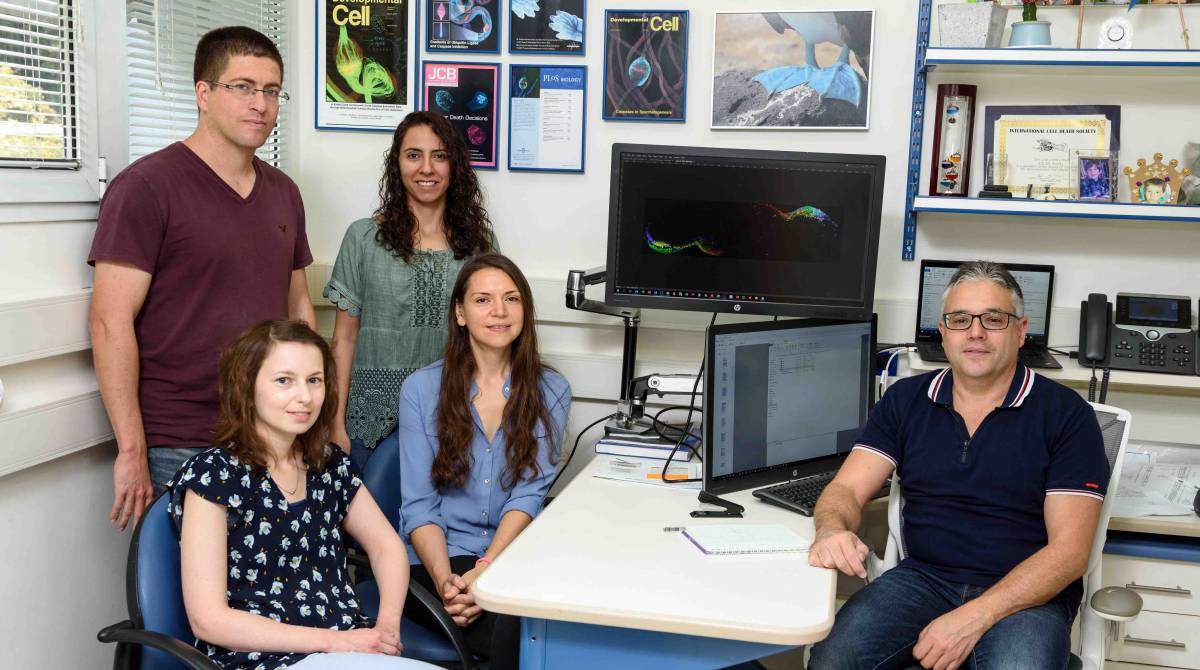עיתונאיות ועיתונאים, הירשמו כאן להודעות לעיתונות שלנו
הירשמו לניוזלטר החודשי שלנו:
If the molecular machines in our cells were as noisy as their factory-sized counterparts, our bodies would be constantly humming. The cell’s demolition machines – enzymes called caspases that under certain circumstances cause the cell to self-destruct – are continuously engaged in low-level, non-deadly activity that has long baffled scientists. Now researchers at the Weizmann Institute of Science have demystified at least one aspect of this low-grade “humming.” Their revelations may help personalize radiation therapy for cancer, and may also help explain how the earliest multicellular animals on Earth managed to keep things together.
In earlier work, the team of Prof. Eli Arama of the Molecular Genetics Department had shown that two “executioner” caspases perform the most critical roles in triggering the type of programmed cell death called apoptosis in the lining tissues of the fruit fly larva. When the scientists removed these caspases by genetic engineering, they got cells that failed to die even when they were “nuked,” causing them to suffer massive DNA damage. In the new study, led by Dr. Anna Gorelick-Ashkenazi, a former PhD student in Arama’s lab, the researchers set out to discover what happens to these so-called “undead” cells over time. The team included Dr. Ron Weiss, Lena Sapozhnikov, Dr. Anat Florentin, Dr. Lama Tarayrah-Ibraheim, Dima Dweik and Dr. Keren Yacobi-Sharon.

The results were surprising: As reported in Nature Communications, the team discovered that 24-48 hours after being irradiated – that is, long after cells with intact caspases usually die – the “undead” cells started moving. The scientists tracked their movement with the help of fluorescent markers and saw that the cells migrated not only within a wing, eye, leg or other emerging organ of a fruit fly larva, but sometimes even crossed over to other organs.
The researchers wanted to know why exactly the lack of caspases could cause “undead” cells to start moving. They performed a series of genetic manipulations to regulate the levels of caspase activity in the fly cells and found that these proteins strongly prevented the migration of the “undead” cells when they were present at levels below the threshold needed to trigger apoptosis. Migration began when caspase activity was so reduced that apoptosis dropped close to zero; it increased sharply when caspase activity ceased altogether. Additional experiments suggested that the caspases may prevent cell migration by – directly or indirectly – keeping down the levels of other enzymes, such as the Rho GTPases, responsible for cell motility, and MMPs, which clip away the molecules holding cells together. MMPs are known to, among other things, facilitate the spread of tumor cells by freeing them from the surrounding matrix.
“We’ve discovered that at levels far below the threshold for inducing apoptosis, caspases perform a crucial function that has nothing to do with cell death,” Arama says. “Rather, these enzymes play a role in the ongoing maintenance of the lining, and maybe also of other tissues, holding cells together by preventing their transition to motile cells – and that’s probably one of the reasons they ‘hum’ at a low level all the time.” Indeed, the scientists found that in places in which caspase activity has been removed in the fruit fly, some of the cells start migrating even without irradiation.
This role of caspases might go back to the ancient past, in which multicellular organisms evolved from single-celled ones that until then had populated Earth. The caspases – found only in animals, but not in plants, fungi, algae or single-celled organisms – may have been one of the stabilizers that held multiple cells together, enabling animal life to evolve into more complex forms. The hold of the caspases would be released only under special circumstances: when cell migration is needed, for example, when emerging organs form in a developing embryo.
On a more practical level, the findings of the new study may help explain why following radiation therapy for cancer, the malignancy sometimes recurs with new vigor. It’s possible that in people with a reduced caspase activity in their bodies, or with very low or nonexistent caspase activity in their tumor cells, the radiation leads to the emergence of “undead” cells that start migrating, leading to the cancer’s spread.
“If our discovery that radiation can cause cell migration is confirmed in mammalian cells, particularly in human cancer cells, it might help explain why in some patients, cancer is not beaten by radiation therapy and even becomes more aggressive,” Arama says. The findings may in the future advance the advent of personalized cancer therapies: If a patient’s caspase activity is found to be too low to keep cells in place following irradiation, it may be a good idea to consider alternative treatments whose outcome is unaffected by caspase activity levels. Moreover, when future research reveals the mechanism by which caspases hold cells together, as well as the signaling mechanisms involved in the acquisition of cell motility after irradiation, it may be possible to design molecules that will interfere with these molecular pathways, preventing the spread of cancer in certain situations.
Prof. Eli Arama's research is supported by the European Research Council. Prof. Arama is the incumbent of the Harry Kay Professorial Chair of Cancer Research.